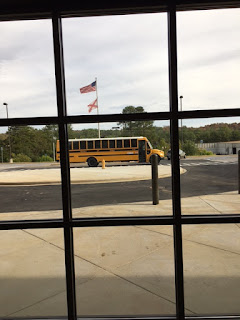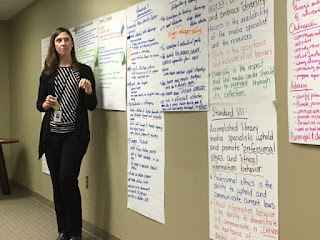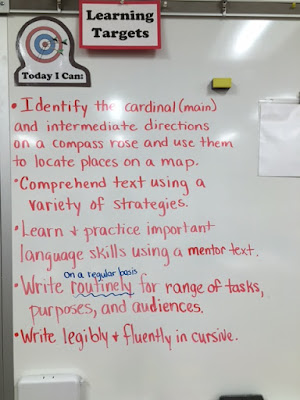The goal of this blog is to inform and update educators on relevant and important issues regarding teaching and learning.
Engaging All Learners
Studio Day April 2019
Thursday, October 27, 2016
Gathering Evidence - Formative Assessment Ideas
Mr. Salem shared this link with his staff today. It has 56 different ways to gather evidence of student achievement.
Tuesday, October 25, 2016
Paine Elementary Hosts Open House
TCS Board members and central office staff were given tours of the new addition to Paine Elementary prior to the community open house. Selected safety patrollers gave guided tours throughout the evening. Classes in the library and nurse services began today in the new facility.
Science Teachers Collaborate
HTHS and HTMS science teachers collaborated for a full day to review science needs, debrief Chromebook use, and to create lesson plans with science coordinator, Dr. Phyllis Faust, and technology integration specialist, Stephanie Hawthorne. Each school will meet 3-4 times throughout the year for full days of collaboration. Secondary science teachers are creating their own curriculum guides, based on Alabama Science Standards, and housing that curriculum in Live Binder. All secondary science teachers utilize classroom sets of Chromebooks.
Thursday, October 20, 2016
TCS Librarians Collaborate
TCS librarians are meeting today to review their standards and to identify the critical components of an effective library media specialist.
The National Board for Professional Teaching Standards has organized
the standards for accomplished library media specialists into the following ten standards. These standards serve as the basis for National Board
Certification in library media.
Standard I: Knowledge of
Students
Accomplished library media specialists understand the academic,
personal, and social characteristics
of students and relate them to learning.
Standard II: Teaching and
Learning
Accomplished library media specialists understand and apply principles
and practices of effective
teaching in support of student learning.
Standard III: Knowledge of
Library and Information Studies
Accomplished library media specialists understand and apply the principles
of library and information studies to support student learning and to create an effective,
integrated library media program.
Standard IV: Leadership
Accomplished library media specialists are visionary leaders in their
schools and in the profession.
Standard VII: Access, Equity,
and Diversity
Accomplished library media specialists provide access, ensure equity,
and embrace diversity.
Standard VIII: Ethics
Accomplished library media specialists uphold and promote professional
ethics and ethical information behavior.
Standard IX: Outreach and
Advocacy
Accomplished library media specialists promote the library media
program through outreach and the
development of advocates.
Standard X: Reflective Practice
Accomplished library media specialists engage in reflective practice to
improve student learning.
Friday, October 14, 2016
Kindergartners LOVE Science
Students in Penny Moore's kindergarten are learning about Motion and Stability. The standard is to investigate the resulting motion of objects when forces of different strengths and directions act upon them. The students' learning target is:
I can determine which object requires more force to be pushed and moved across a finish line.
I can determine which object requires more force to be pushed and moved across a finish line.
Elementary Technology Teachers Collaborate
Elementary technology teachers met at central office today to collaborate and to provide support to one another. The technology teachers created assignments for potential elearning days and have those assignments ready in the event that schools are closed due to weather conditions. The teachers also worked to create sessions in STIPD for each school. Work was also done on the schools' websites.
Labels:
Collaboration,
Professional Learning,
Technology
Tuesday, October 4, 2016
HTHS Reads!
Doug Lemov, in his book, Reading Reconsidered, states:
Dr. Cardwell and I received an email today from HTHS English teacher, Lacey DeShazo. Lacey said that during her prep period today, she walked into the library to see librarian Laura Massey poring over data she had collected from 9th grade students. She was matching each student in Lyon Dove's class to a book using their listed interests. These students will read these books outside of class while they study another novel in class. Lacey thought that was cool, so she sent us a picture she snapped.
Reading independently is ultimately how students read on exams,
in college, and in their adult lives, so it is especially important to
give them lots of practice in doing so. There is clear consensus
that all kids should have ample opportunities to read independently,
which is why in countless schools and homes across this country,
parents and teachers alike stress the importance of making sure that
students have a book in their hand as much as possible.
HTHS teachers of various subjects are meeting during Lunch and Learn meetings to look at reading scores and to talk about reading and how they can support literacy growth in their classrooms. HTHS teachers know the significance of volume reading, and they are encouraging students to read more.
Teacher Collaboration: Matching Complementary Strengths
Click here to read this entire informative article about collaboration from edutopia.
At Wildwood IB World Magnet School, in Chicago, teacher collaboration fosters a supportive professional culture, lessens teacher conflict, and provides students with schoolwide best practices.
Spreading Best Practices Schoolwide
Teacher collaboration at Wildwood helps to diffuse conflicting adult dynamics, fosters a collaborative culture that puts the students' learning first, and turns a teacher's best practice into a schoolwide best practice.
Teacher collaboration is a top priority at Wildwood. Here is what works for them:
•Teachers share work products on a common drive.
•Teacher preparation time is aligned by grade level, creating grade-level teams.
•Protocols and agendas are set up to help conflicting personalities learn to appreciate each other and work well together.
"So often we hold all the good things we do to ourselves because it becomes kind of a like a competition," says fourth-grade teacher Karl Wiedegreen. "We should be helping each other, and stop holding in all the things that we do great, and share it with others so that they can make those same gains within their classroom."
Even without meeting in person, they have instant access to work products, like:
Making time for that collaboration is often a burden that falls to the school's leadership. Mary Beth Cunat, Wildwood's principal, plays a large role in scheduling time for teachers. "A principal must do what it takes to remove the obstacle of 'too much to do' and 'not enough time,'" says Cunat.
Leveraging the master schedule to ensure common preparation time between her teachers is one way that Cunat helps make collaboration work for them.
"When we have our preps," says Wiedegreen, "they're aligned to each other so that those grade-level teams can meet and work together on anything that we're doing in our units. We can look together and say, 'OK, what are we working on? What are we doing? Are we in the same area? Are we at the same pace?'"
"When teachers are able to collaborate and have planning time during the day, especially built into the schedule, you have somebody there, a partner that has your back and will be there --because teaching is quite difficult," says fourth-grade teacher Georgia Melidis. "It's very involved. We wear many hats, and you need somebody there that really understands you, and supports you, and is there sometimes to vent to, or to ask to help problem solve."
Cunat works in other ways to support her teachers in making time for collaboration:
At Wildwood IB World Magnet School, in Chicago, teacher collaboration fosters a supportive professional culture, lessens teacher conflict, and provides students with schoolwide best practices.
Spreading Best Practices Schoolwide
Teacher collaboration at Wildwood helps to diffuse conflicting adult dynamics, fosters a collaborative culture that puts the students' learning first, and turns a teacher's best practice into a schoolwide best practice.
Teacher collaboration is a top priority at Wildwood. Here is what works for them:
•Teachers share work products on a common drive.
•Teacher preparation time is aligned by grade level, creating grade-level teams.
•Protocols and agendas are set up to help conflicting personalities learn to appreciate each other and work well together.
"So often we hold all the good things we do to ourselves because it becomes kind of a like a competition," says fourth-grade teacher Karl Wiedegreen. "We should be helping each other, and stop holding in all the things that we do great, and share it with others so that they can make those same gains within their classroom."
How It's Done
Virtual Collaboration: Share Work Products on a Common Drive
By sharing work products on Google Drive, Wildwood teachers know what their colleagues outside of their collaboration group are doing. They also know how they're doing it. This enables them to replicate and/or get ideas from each other.Even without meeting in person, they have instant access to work products, like:
- Unit plans
- Lesson plans
- Curriculum maps
Schedule Time for Collaboration
"Teacher collaboration at Wildwood is really intentional," says fourth-grade teacher Karl Wiedegreen. "It's intentional with the common preps we have. We have grade-level meetings. We have opportunities when we want to come in the morning to work together, stay in the afternoon and work together."Making time for that collaboration is often a burden that falls to the school's leadership. Mary Beth Cunat, Wildwood's principal, plays a large role in scheduling time for teachers. "A principal must do what it takes to remove the obstacle of 'too much to do' and 'not enough time,'" says Cunat.
Leveraging the master schedule to ensure common preparation time between her teachers is one way that Cunat helps make collaboration work for them.
"When we have our preps," says Wiedegreen, "they're aligned to each other so that those grade-level teams can meet and work together on anything that we're doing in our units. We can look together and say, 'OK, what are we working on? What are we doing? Are we in the same area? Are we at the same pace?'"
"When teachers are able to collaborate and have planning time during the day, especially built into the schedule, you have somebody there, a partner that has your back and will be there --because teaching is quite difficult," says fourth-grade teacher Georgia Melidis. "It's very involved. We wear many hats, and you need somebody there that really understands you, and supports you, and is there sometimes to vent to, or to ask to help problem solve."
Cunat works in other ways to support her teachers in making time for collaboration:
- She provides a substitute teacher for half days once per quarter to ensure collaborative work.
- She provides extra time for peer-to-peer observation.
- She offers to create an agenda for teacher preparation once per week.
- She encourages her teachers to attend conferences, school site visits, and professional development together.
- She invites her teams to share out at school-wide staff meetings.
- She encourages all staff to leave their doors open, fostering a transparent, collaborative environment.
Monday, October 3, 2016
HTMS Hosts EdCamp
HTMS held their first EdCamp of the year this afternoon.
Teachers sign up to facilitate sessions.
Ann Bettis leads a session about math sprints.
Sessions are posted in the hallway for teachers to choose where they want to attend.
April Chamberlain shares info about KYTE with Tyler Marlow.
Mrs. Berry gives away prizes to teachers who facilitated.
HTMS Library Circulation Increases
WOW!!! Circulation for September Up 62%!
Teachers sent students into the school's library for books throughout the month of September, and the circulation numbers SHOWED it! The HTMS book circulation rose 62% over this month last year, increasing from 1,321 items to 2,136 items! HTMS is building their Reading Culture!
Educator Effectiveness Week 3 of Peer Observations: Learning Targets
After observing a colleague's class, teachers are posting their reflections in their Google Classroom.
Teresa Bivens Oct 1
This week I observed Gina Gamble's learning targets for her Second Grade class. The targets are placed on her cabinets where they are easily accessible for all students to see. I noticed they were kid friendly and the verbiage was broken down for students to have further understanding of what they are trying to accomplish through the learning targets.
Lauren Blake Sept 30
This morning I observed Lauren Long's 5th grade technology class. Before the students arrived, I went into the classroom and noticed her learning targets written on the board. The learning targets were clear, concise, and written in kid-friendly terms. When the students arrived to the computer classroom, Mrs. Long discussed the learning targets in the hall before students entered the classroom. I thought this was very effective because we all know how students like to touch the computers as soon as they walk into the room! Before allowing the students to enter the classroom, Mrs. Long had them summarize the learning targets to ensure understanding. Great job Lauren Long!
Cynthia Weyerman Sept 28
Ms. Harper had an amazing art lesson with a kindergarten class today. Her learning targets were clearly displayed. I can recognize and name shapes, visualize emotions and moods, and use supplies properly. The lesson clearly helped the children do all of these things. They created a collage based on the book Elmer in which they used shapes that she had them name and describe. The students communicated how their collage expressed feelings such as being surprised. She closed the lesson by having the students explain what they were able to do as described in the learning target. The students explained how they used the glue properly. Wonderful classroom environment! I enjoyed it very much.
Teresa Bivens Oct 1
This week I observed Gina Gamble's learning targets for her Second Grade class. The targets are placed on her cabinets where they are easily accessible for all students to see. I noticed they were kid friendly and the verbiage was broken down for students to have further understanding of what they are trying to accomplish through the learning targets.
Lauren Blake Sept 30
This morning I observed Lauren Long's 5th grade technology class. Before the students arrived, I went into the classroom and noticed her learning targets written on the board. The learning targets were clear, concise, and written in kid-friendly terms. When the students arrived to the computer classroom, Mrs. Long discussed the learning targets in the hall before students entered the classroom. I thought this was very effective because we all know how students like to touch the computers as soon as they walk into the room! Before allowing the students to enter the classroom, Mrs. Long had them summarize the learning targets to ensure understanding. Great job Lauren Long!
Cynthia Weyerman Sept 28
Ms. Harper had an amazing art lesson with a kindergarten class today. Her learning targets were clearly displayed. I can recognize and name shapes, visualize emotions and moods, and use supplies properly. The lesson clearly helped the children do all of these things. They created a collage based on the book Elmer in which they used shapes that she had them name and describe. The students communicated how their collage expressed feelings such as being surprised. She closed the lesson by having the students explain what they were able to do as described in the learning target. The students explained how they used the glue properly. Wonderful classroom environment! I enjoyed it very much.
Subscribe to:
Posts (Atom)
































